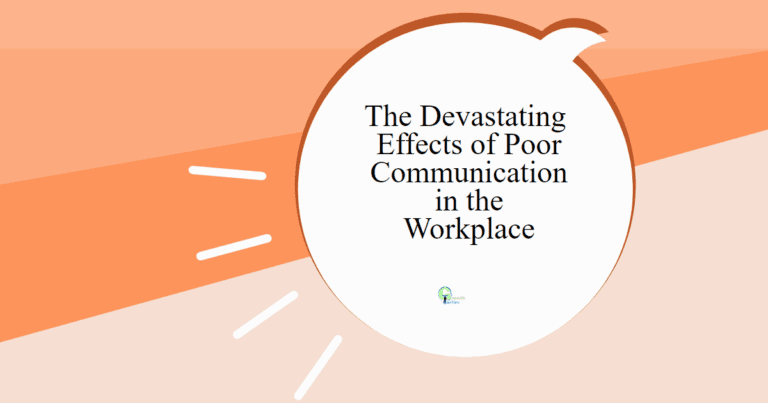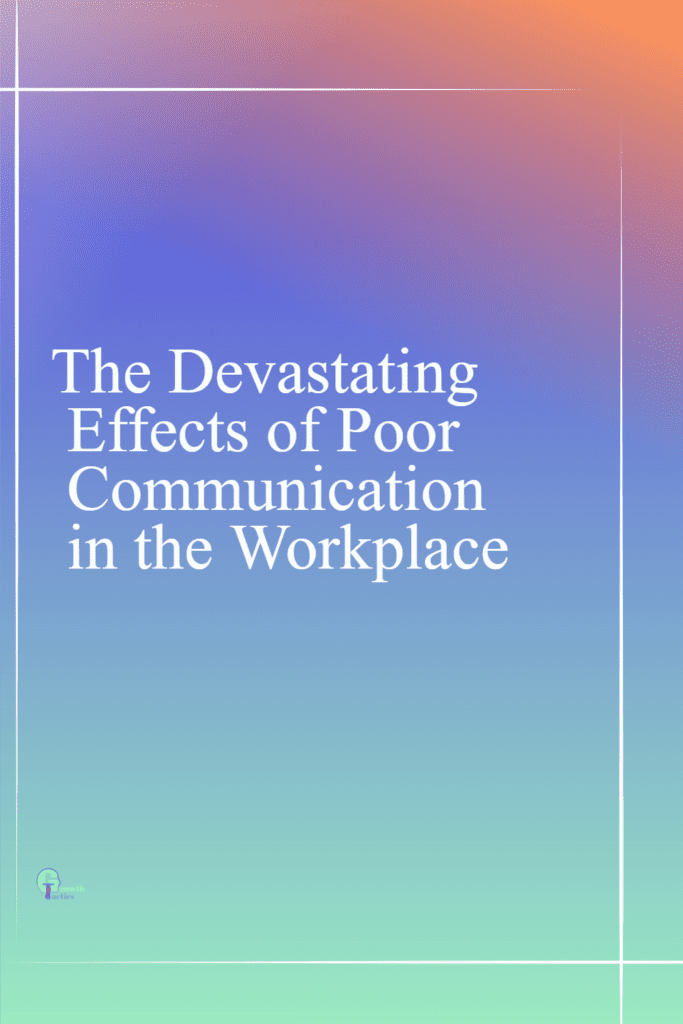We are going to explore the fascinating world of communication and delve into the ripple effects that poor communication can have on our lives. It’s a topic that affects us all, whether in our personal relationships, workplace dynamics, or even in the larger context of society. So, let’s dive in and uncover the hidden consequences of ineffective communication.
Jump To Section
Understanding the Scope of Poor Communication in the Workplace
Before we can fully grasp the impact of poor communication, it’s essential to define what it entails. Poor communication can take many forms, ranging from ineffective verbal or non-verbal cues to a lack of clarity in expressing thoughts and emotions. Its effects can be felt across various aspects of our lives.
Deteriorating Personal Relationships
In personal relationships, poor communication can slowly chip away at the foundation of trust and intimacy that forms the basis for healthy connections. Misunderstandings and conflicts often arise due to a lack of clarity in conveying our thoughts and emotions, leading to misinterpretations. As a result, small issues can escalate into significant conflicts, causing strain in relationships.
Moreover, poor communication makes it challenging to build trust and vulnerability, which are crucial for establishing deep and meaningful connections. Frequent misunderstandings can erode the sense of intimacy, creating emotional distance between partners. Ultimately, this emotional distancing leads to relationship dissatisfaction and unhappiness.
The emotional and psychological toll of poor communication should not be underestimated. Constant misunderstandings and an inability to effectively express one’s feelings can leave individuals feeling lonely, isolated, and resentful. Stress levels tend to soar, impacting mental well-being and overall satisfaction within relationships.
Compromised Workplace Dynamics
Poor communication within the workplace can have detrimental effects on efficiency, productivity, and overall job satisfaction. Lack of clear instructions often leads to errors and delays, which can hinder progress and negatively impact work quality. In turn, this creates a domino effect, influencing team dynamics and causing misalignments between colleagues.
Collaboration and teamwork suffer immensely due to poor communication practices. Ineffective information sharing hampers the ability to work together seamlessly, causing delays and misunderstandings. It becomes increasingly challenging to resolve conflicts and reach a consensus when communication channels are not well-established. These issues can breed negativity and reduce employee morale, ultimately affecting job satisfaction and employee turnover rates.
Managerial challenges arise as well when communication is lacking. Supervisors struggle to provide clear feedback and constructive criticism, hindering their ability to guide and motivate their employees. The lack of effective communication not only diminishes employee engagement but also creates a breakdown in hierarchical structures and decision-making processes, further impacting organizational success.
Wider Societal Implications
Beyond personal relationships and workplaces, the repercussions of poor communication extend to a larger societal scale. Cultural and social barriers, such as language differences or misunderstandings due to cultural norms, can impede effective communication between individuals from different backgrounds. Stereotyping and biases further complicate matters, creating miscommunication and barriers to inclusivity.
On a political and global level, the devastating effects of poor communication cannot be ignored. Miscommunication can fuel conflicts and tensions between nations, hindering diplomatic relationships and obstructing progress on critical global challenges. The inability to effectively communicate and understand each other’s perspectives obstructs collaboration and the ability to achieve resolutions.
Strategies for Enhancing Communication Skills
Now that we’ve explored the dire consequences of poor communication, it’s time to discuss strategies for improving our communication skills. By investing time and effort into enhancing our ability to communicate effectively, we can foster healthier relationships and create a more harmonious environment around us.
1. Be clear and concise:
Ineffective communication often stems from being unclear or overly verbose in our messages. To ensure your communication is effective, use simple and straightforward language. Instead of using jargon or complicated terms, choose words that are easily understood by everyone involved.
This allows your message to be received and comprehended without confusion or misunderstanding. Additionally, when delivering your message, aim to be concise. Streamline your thoughts and deliver your message in a succinct manner, focusing on the key points. This not only keeps your audience engaged but also ensures that your message is not diluted or overshadowed by unnecessary information.
2. Listen actively:
Active listening is an essential skill for effective communication. It involves fully focusing on the speaker and understanding their message. To practice active listening, pay attention to what the speaker is saying, their tone of voice, and their body language. Avoid interrupting or formulating your response while they are still speaking.
Instead, give them your undivided attention and hold back judgment until they have finished. Seek to understand their perspective and aim to empathize with their point of view. By actively listening, you can foster a deeper understanding, build stronger relationships, and enhance your ability to communicate effectively.
3. Show empathy:
Empathy is the ability to understand and share the feelings of others. It plays a crucial role in effective communication because it allows us to connect with others on a deeper level. By putting ourselves in the shoes of the other person, we can gain insight into their emotions, experiences, and motivations.
This understanding enables us to respond in a more compassionate and respectful way. When communicating, make an effort to acknowledge and validate the other person’s feelings. Demonstrate empathy through your words and actions, showing them that you genuinely care about their perspective. This creates a safe and supportive environment for open and honest communication.
4. Avoid assumptions:
Assumptions can be detrimental to effective communication, as they often lead to misunderstandings and miscommunication. Avoid assuming that others know what you are thinking or that you fully understand what they mean. Instead, ask questions and seek clarification to ensure a clear understanding.
This demonstrates your willingness to listen and learn, creating an environment where communication can thrive. By avoiding assumptions, you encourage open dialogue, promote active engagement, and reduce the chances of misinterpreting or miscommunicating vital information.
5. Use non-verbal communication:
Non-verbal communication goes beyond words and plays a significant role in how we express ourselves and understand others. It includes body language, facial expressions, gestures, and tone of voice. Being aware of your non-verbal cues and using them intentionally can greatly enhance your effectiveness as a communicator. For example, maintaining eye contact demonstrates engagement and attentiveness, while leaning forward can show interest and understanding.
Your facial expressions can also convey emotions and meaning, emphasizing or reinforcing your verbal message. By aligning your non-verbal communication with your verbal message, you ensure consistency and facilitate better understanding and connection with your audience.
6. Be respectful:
Respect is a vital component of effective communication. It sets the tone for the conversation, establishes trust, and encourages open dialogue. Treat others with kindness, regardless of any differences in opinion or perspective. Remember to actively listen, seek to understand, and avoid dismissive or condescending language.
Foster an atmosphere of mutual respect by valuing the thoughts and feelings of others. Respecting others’ viewpoints fosters collaboration, encourages diverse perspectives, and leads to more meaningful and productive conversations.
7. Practice active feedback:
Providing feedback is crucial for growth and improvement in communication. When offering feedback, focus on being constructive and supportive. Avoid criticizing or belittling the other person’s efforts. Instead, provide specific examples and suggest areas for improvement.
By offering meaningful feedback, you help others develop their communication skills and promote a culture of continuous learning. Encourage open communication channels where everyone feels comfortable giving and receiving feedback, fostering an environment of growth and improvement.
8. Watch your tone:
The tone you use during communication greatly affects how your message is received. A positive and friendly tone can help create a pleasant and productive atmosphere. Be mindful of your tone, aiming to speak in a manner that is warm and respectful.
Consider the impact your words and tone may have on the recipient and adjust accordingly. By using a friendly and positive tone, you can facilitate better understanding, build rapport, and foster stronger relationships.
9. Use visual aids:
When discussing complex ideas or information, incorporating visual aids can greatly improve understanding and engagement. Visual aids can range from simple diagrams and charts to more sophisticated presentations. They help simplify complex concepts and make them more accessible to the audience.
By using visual aids, you provide a visual representation of your message, enhancing clarity and comprehension. Visual aids also add variety to your communication, making it more engaging and memorable for the recipients.
10. Follow up:
Following up after a conversation or discussion is essential to ensuring that everyone is on the same page. After engaging in a discussion or meeting, take the time to summarize the key points discussed and decisions made. Send a confirmation email or document to all participants, emphasizing the main takeaways and any next steps.
This follow-up serves as a reference and helps to avoid misunderstandings in the future. It also demonstrates your commitment to effective communication and solidifies the shared understanding amongst all involved parties.
“Clear communication bridges gaps, opens hearts, and transforms relationships. Discover the lasting impact of effective communication in our latest blog post: [insert link] #LostInTranslation #CommunicationMatters”
Wrapping Up the Effects of a Lack of Communication
Poor communication can cast a dark shadow over our relationships, workplace dynamics, and society as a whole. It is essential to recognize the damaging effects it can have and the profound influence effective communication can have on our lives.
By actively working on improving our communication skills, such as active listening, clarity, and trust-building, we can forge healthier relationships, work more effectively within our teams, and contribute towards creating a more inclusive and understanding society.
So, take a moment to reflect on your communication style and consider implementing some of these strategies. Let’s strive to bridge the communication gaps and bring light to the areas where misunderstanding and miscommunication once thrived.
Thank you for joining us on this journey of exploring the consequences of poor communication and the ways we can enhance our interpersonal connections. We hope you found this blog enlightening and inspiring! Until next time!


